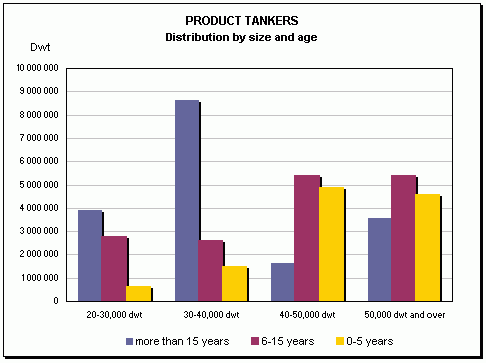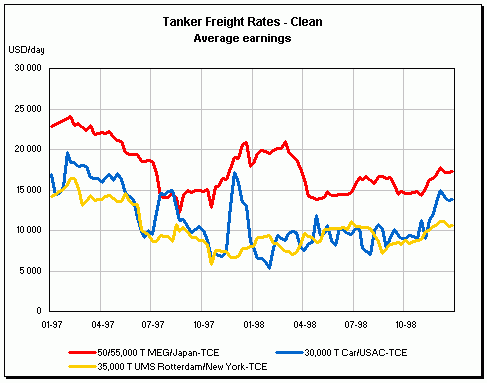
The Tanker Market in 1998
THE TRANSPORT OF REFINED PRODUCTS
|
| Throughout 1998 the oil freight rates market, and particularly that of
refined products carriers, suffered from the climate of uncertainty generated by the world
economic situation: persistence of the Asian crisis, doubts about American growth,
accentuated by the fallout from the financial crisis in the USA economic zone. Factors related to the oil market itself have not favored correction of this
trend: wide variations in crude oil prices, weakness of trading margins.
In general, despite the good half-year results recorded by the oil
companies, doubt prevailed. The lack of visibility led protagonists to favour short-term
operations and made them prudent in their approach to the future, at the same time as the
consolidation movements observed showed that the cards were being redealt.

|
| Fundamental factors
The higher-capacity ships (LR1 and LR2) benefited from a relatively
stable market, particularly for the LR2s whose main MEG/Far-East route practically avoided
the effects of the Asian crisis. The LR1s, more severely affected, often encroached on the
market of smaller ships, particularly in the Atlantic.
Ships of 40,000-45,000 dwt suffered greatly from the crisis of
confidence in the market. The number of ships available, the competition from larger ships
and the weakness of the chemicals market are sufficient explanation for the drop in
freight rates observed in 1998.
Although the application of the ISM code does not seem to have had a
significant effect, it is clear that the preference of charterers to work with quality
shipowners and equipment became more pronounced through the year. Moreover, a degree of
reluctance by port authorities with respect to non-SBT ships could be observed.
- The tonnage supply continued to increase
Modernization of the refined product carrier fleet continued and the
average size continued to increase: out of a total of more than 1,100 ships, totaling more
than 45 million dwt, ships of 40,000 dwt and more now represent more than 56%, and more
than 82% of these ships are less than five years old.
A negligible number of ships were retired from the fleet, while more
than 25 ships, totaling around 1,100,000 dwt, were delivered.
Many ships built to work in emerging markets (MTBE or methanol, or even
pure chemical carriers) were employed to carry refined products. This phenomenon, together
with the large number of ships due for delivery in 1999 and the growth in average size, is
likely to result in a fall in average yields if, as most observers think, demand continues
to stagnate. |
| Freight rate analysis The recovery in rates observed from mid-October must not hide the mediocrity of
the average yields observed in 1998 (about 10% below those of the previous year).
Nevertheless, the most pessimistic forecasts were not confirmed: the market recovered
slightly after reaching a low point between December 1997 and February 1998.

LR and MR were not able to maintain the levels reached at the end of
1997.
The LR1 (greater than 50,000 dwt) rates reached $14,500/day in the
middle of the year, then recovered slightly before exceeding $15,000/day at the beginning
of November and continuing a steady increase to reach $18,000/day at the end of the year.
The LR2 (greater than 70,000 dwt) market showed greater stability,
reflecting the particular interest of charterers in the region for this type of ship and
the existence of commercial agreements between shipowners.
The Far East and the Indian market remained the favorite zones for the
40,000-45,000 dwt ships, which managed to obtain acceptable yields ($13,000-13,500/day).
The weak American demand meant that rates rarely exceeded $10,000/day
for Europe / USA voyages. There were very few inter-zone voyages (Europe or USA / Far
East).
Strong competition from larger ships (55,000 dwt or more) was
experienced for gas oil cargoes (ex-Ventspils in particular).
The period charter market showed low activity, reflecting the reluctance
of the charterers and their ability to cover their needs on the spot market. Nevertheless,
at the end of the year the oil companies renewed a large part of their time charters,
profiting from favorable terms: a 10-12% reduction ($13,500/day for a modern 45,000 dwt
vessel). |
| Prospects It
is hard to be very optimistic for 1999: the balance between tonnage supply and demand
could be difficult to maintain given the prospects for stagnation of demand.
However, the increased stringency of the technical requirements
disqualifies a significant part of the oldest tonnage on a day-to-day basis. A small
increase in demand would be enough to stabilize the market at present levels.
We feel that 1999 will be a year fairly similar to 1998, marked by
yields that are mediocre without being catastrophic. |
| The refined product carrier second-hand
marketIf IMO class 2/3
ships with capacities between 20,000 dwt and 50,000 dwt are included, only 40 ships were
sold in 1998, half as many as in the previous year. This number drops to about 30 units if
only pure product tankers are considered. The trend in activity that we recorded in the
last quarter of 1997 has thus continued, with very few transactions. Only four of the 30
ships sold were less than 10 years old. This is due partly to the very weak tonnage supply
on the market but above all, and once again, to the preference of the shipowners for
newbuilding because of the significant price reductions proposed by the shipyards. Our
examples include the resale by the Kherson yard of a 29,500 dwt vessel for $28,000,000 in
February with a 10-year charter attached and the sale of the M/T "Osco Star",
40,503 dwt, built in 1989, for $15,400,000.
Most of the activity thus concerned ships built between 1975 and 1985
(20 ships). Note that a significant part of the ships built in the 1980s were bought by
American investors. This was the case for the sister ships "Clipperventure L",
"Conquestventure L", "Courageventure L" and "Crystalventure
L", 31,700 dwt, built in 1980 and 1981, sold as a block for a total price of around
$42,000,000 with five to six years of bare-boat back charter. For buyers of the same
nationality, examples include the sale in May of the M/T "Brali", 48,581 dwt,
built in 1985, for $17,000,000. The oldest ships found buyers among operators in the
Mediterranean market, mainly in Italy and Greece, and the following sales were noted: the
M/T "Enalios Avra", 37,561 dwt, for $3,800,000 and the M/T "Sea
Champion", 36,572 dwt, built in 1973, for $2,500,000. |
Shipping and Shipbuilding Markets 1999
I N D E X
|